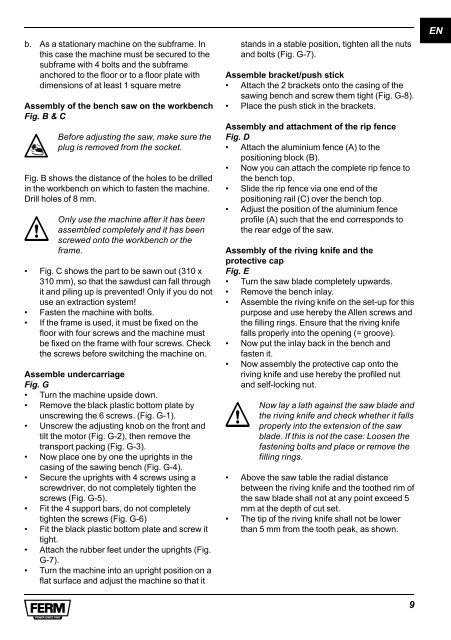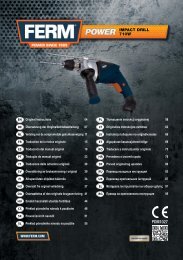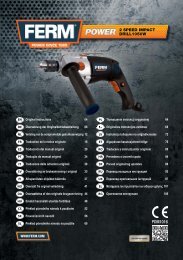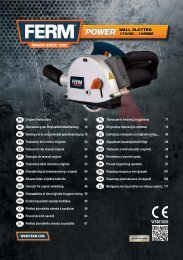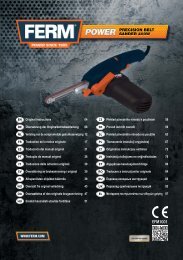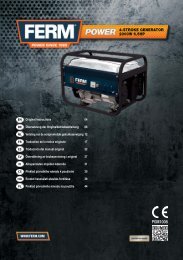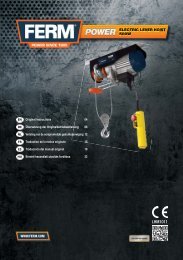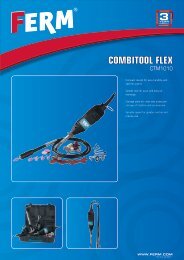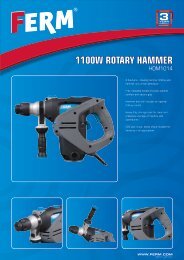Create successful ePaper yourself
Turn your PDF publications into a flip-book with our unique Google optimized e-Paper software.
. As a stationary machine on the subframe. In<br />
this case the machine must be secured to the<br />
subframe with 4 bolts and the subframe<br />
anchored to the floor or to a floor plate with<br />
dimensions of at least 1 square metre<br />
Assembly of the bench saw on the workbench<br />
Fig. B & C<br />
Before adjusting the saw, make sure the<br />
plug is removed from the socket.<br />
Fig. B shows the distance of the holes to be drilled<br />
in the workbench on which to fasten the machine.<br />
Drill holes of 8 mm.<br />
Only use the machine after it has been<br />
assembled <strong>com</strong>pletely and it has been<br />
screwed onto the workbench or the<br />
frame.<br />
• Fig. C shows the part to be sawn out (310 x<br />
310 mm), so that the sawdust can fall through<br />
it and piling up is prevented! Only if you do not<br />
use an extraction system!<br />
• Fasten the machine with bolts.<br />
• If the frame is used, it must be fixed on the<br />
floor with four screws and the machine must<br />
be fixed on the frame with four screws. Check<br />
the screws before switching the machine on.<br />
Assemble undercarriage<br />
Fig. G<br />
• Turn the machine upside down.<br />
• Remove the black plastic bottom plate by<br />
unscrewing the 6 screws. (Fig. G-1).<br />
• Unscrew the adjusting knob on the front and<br />
tilt the motor (Fig. G-2), then remove the<br />
transport packing (Fig. G-3).<br />
• Now place one by one the uprights in the<br />
casing of the sawing bench (Fig. G-4).<br />
• Secure the uprights with 4 screws using a<br />
screwdriver, do not <strong>com</strong>pletely tighten the<br />
screws (Fig. G-5).<br />
• Fit the 4 support bars, do not <strong>com</strong>pletely<br />
tighten the screws (Fig. G-6)<br />
• Fit the black plastic bottom plate and screw it<br />
tight.<br />
• Attach the rubber feet under the uprights (Fig.<br />
G-7).<br />
• Turn the machine into an upright position on a<br />
flat surface and adjust the machine so that it<br />
stands in a stable position, tighten all the nuts<br />
and bolts (Fig. G-7).<br />
Assemble bracket/push stick<br />
• Attach the 2 brackets onto the casing of the<br />
sawing bench and screw them tight (Fig. G-8).<br />
• Place the push stick in the brackets.<br />
Assembly and attachment of the rip fence<br />
Fig. D<br />
• Attach the aluminium fence (A) to the<br />
positioning block (B).<br />
• Now you can attach the <strong>com</strong>plete rip fence to<br />
the bench top.<br />
• Slide the rip fence via one end of the<br />
positioning rail (C) over the bench top.<br />
• Adjust the position of the aluminium fence<br />
profile (A) such that the end corresponds to<br />
the rear edge of the saw.<br />
Assembly of the riving knife and the<br />
protective cap<br />
Fig. E<br />
• Turn the saw blade <strong>com</strong>pletely upwards.<br />
• Remove the bench inlay.<br />
• Assemble the riving knife on the set-up for this<br />
purpose and use hereby the Allen screws and<br />
the filling rings. Ensure that the riving knife<br />
falls properly into the opening (= groove).<br />
• Now put the inlay back in the bench and<br />
fasten it.<br />
• Now assembly the protective cap onto the<br />
riving knife and use hereby the profiled nut<br />
and self-locking nut.<br />
Now lay a lath against the saw blade and<br />
the riving knife and check whether it falls<br />
properly into the extension of the saw<br />
blade. If this is not the case: Loosen the<br />
fastening bolts and place or remove the<br />
filling rings.<br />
• Above the saw table the radial distance<br />
between the riving knife and the toothed rim of<br />
the saw blade shall not at any point exceed 5<br />
mm at the depth of cut set.<br />
• The tip of the riving knife shall not be lower<br />
than 5 mm from the tooth peak, as shown.<br />
9<br />
EN


